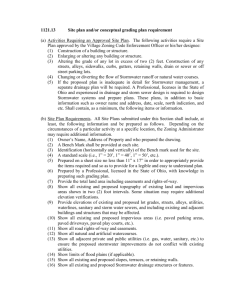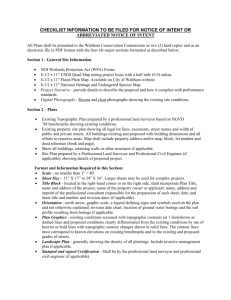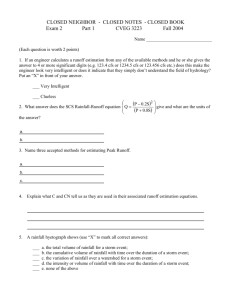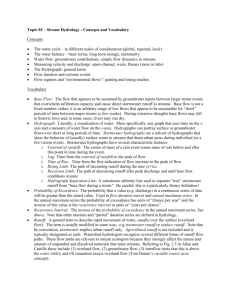Integrating Simulation and Design for Stormwater
advertisement
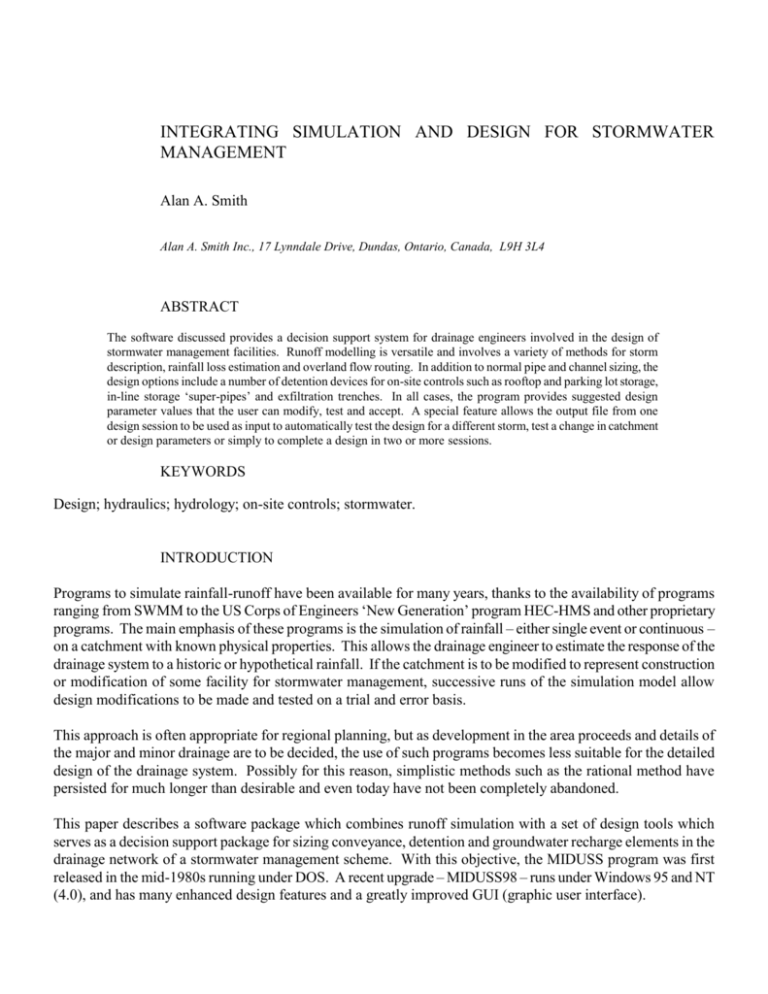
INTEGRATING SIMULATION AND DESIGN FOR STORMWATER MANAGEMENT Alan A. Smith Alan A. Smith Inc., 17 Lynndale Drive, Dundas, Ontario, Canada, L9H 3L4 ABSTRACT The software discussed provides a decision support system for drainage engineers involved in the design of stormwater management facilities. Runoff modelling is versatile and involves a variety of methods for storm description, rainfall loss estimation and overland flow routing. In addition to normal pipe and channel sizing, the design options include a number of detention devices for on-site controls such as rooftop and parking lot storage, in-line storage ‘super-pipes’ and exfiltration trenches. In all cases, the program provides suggested design parameter values that the user can modify, test and accept. A special feature allows the output file from one design session to be used as input to automatically test the design for a different storm, test a change in catchment or design parameters or simply to complete a design in two or more sessions. KEYWORDS Design; hydraulics; hydrology; on-site controls; stormwater. INTRODUCTION Programs to simulate rainfall-runoff have been available for many years, thanks to the availability of programs ranging from SWMM to the US Corps of Engineers ‘New Generation’ program HEC-HMS and other proprietary programs. The main emphasis of these programs is the simulation of rainfall – either single event or continuous – on a catchment with known physical properties. This allows the drainage engineer to estimate the response of the drainage system to a historic or hypothetical rainfall. If the catchment is to be modified to represent construction or modification of some facility for stormwater management, successive runs of the simulation model allow design modifications to be made and tested on a trial and error basis. This approach is often appropriate for regional planning, but as development in the area proceeds and details of the major and minor drainage are to be decided, the use of such programs becomes less suitable for the detailed design of the drainage system. Possibly for this reason, simplistic methods such as the rational method have persisted for much longer than desirable and even today have not been completely abandoned. This paper describes a software package which combines runoff simulation with a set of design tools which serves as a decision support package for sizing conveyance, detention and groundwater recharge elements in the drainage network of a stormwater management scheme. With this objective, the MIDUSS program was first released in the mid-1980s running under DOS. A recent upgrade – MIDUSS98 – runs under Windows 95 and NT (4.0), and has many enhanced design features and a greatly improved GUI (graphic user interface). SOLUTION PROCEDURE The drainage network is represented as a tree of N nodes connected by (N-1) links representing conveyance, detention or diversion devices (Fig. 1(a)). Each node represents a point at which runoff may be introduced. Since the network is a spanning, non-circuited tree, nodes can have any number of inputs but only one output. For this reason, links and their associated hydrographs are assigned the same number as the upstream node (Fig 1(b)). For a given rainfall event, the solution takes the form of a marching solution which moves downstream computing flow hydrographs for the entire time-horizon at successive stations or nodes. At junctions, the accumulated hydrograph is stored to allow other tributary branches to be processed. When the flow from all contributing branches has been computed the solution continues downstream towards the root of the tree or outflow point. 7 101 12 O verlandflow 102 8 O utflow 101 9 3 102 102Inflow 10 11 4 O utflow 102 103 5 6 Fig. 1 – (a) Drainage network representation and (b) node numbering convention. Some programs, such as EXTRAN, use a time-wise marching solution which has the important advantage of taking into account the potential effect of backwater on the capture capacity of a minor system. On the other hand, the downstream marching solution used in MIDUSS98 allows the program to be much more interactive, allowing the designer to work downstream in a logical fashion not unlike the approach taken in the old rational method. At each location in the network, the user can see the entire hydrograph and gauge the extent to which runoff simulation is reasonable and also the effectiveness of proposed design elements in the drainage network in achieving the objectives of stormwater management. Errors can be corrected or design decisions refined before the results are transmitted downstream. HYDROLOGY In general, the hydrological modelling methods used in MIDUSS98 are well recognized and quite versatile. Five single event storms, three rainfall abstraction models and four overland flow routing methods provide a wide range of modelling options. This allows easy examination of the sensitivity of results to the choice of algorithm – a feature appreciated equally by both professional engineers and teachers. In addition to alternative methods for generating runoff from a catchment there are capabilities to add baseflow and to model a large, reasonably homogeneous catchment as a ‘lumped area’ without having to resort to unreasonable values for the overland routing parameters. Storm definition options Five options are available to define (i) a Chicago hyetograph, (ii) one of four Huff quartile rainfall distributions, (iii) a user-defined mass rainfall distribution, (iv) a Canadian Atmospheric Environment Service (AES) storm and (v) a historic storm. In the current release, all five options are for single event storms. Continuous rainfall simulation will be added in a future release. However, single event storms are often preferable in a design situation because: small time steps may be desirable for sub-areas with a short time of concentration. single event storms facilitate the downstream marching solution, which permits interactive modelling and design procedures. historic storms of 48 hours duration or more can be modelled easily which is often adequate for significant events. The Chicago hyetograph can be defined using a multiple of the defined time-step to avoid unrealistic peak intensities when t 5 minutes. In addition to the standard Huff distributions, a number of popular storm ‘shapes’ are included such as the US Soil Conservation Service (SCS) 6-hour and 24-hour standard storms, and Hurricane Hazel (Ontario regional storm) and others. Storms can also be stored and retrieved as files. Rainfall Loss Description These currently include (i) the Soil Conservation Service Curve Number (CN) method, (ii) a volumetric runoff coefficient C, (iii) the Horton equation and (iv) the Green & Ampt method. With the SCS method, either CN or C can be defined and the other value is computed for the currently defined storm and displayed. Similarly, the initial abstraction Ia can be defined explicitly as a depth or implicitly as a fraction of the potential storage S. All methods can be used to generate an effective rainfall hyetograph with duration equal to the storm duration. When used with the SWMM RUNOFF algorithm the Horton and Green & Ampt methods are used as a surface water budget model in which excess surface moisture may persist well after the end of rainfall. Runoff Calculation Pervious and impervious fractions are modelled separately and the direct runoff hydrographs are added. This can result in double-peaked hydrographs with significant differences in the time to peak. This is important in design; for example: (a) A high post-development peak flow may have a relatively small volume that can be handled easily with onsite storage. (b) A commercial area near the downstream end of a large receiving stream may generate a post-development runoff that is dissipated before the peak of the mainstream hydrograph arrives. This can reduce or eliminate the need for peak shaving. The overland flow routing method can be selected from the following four options. (i) A dynamic triangular response function in which time of concentration varies with the intensity of the effective rainfall (ii) A rectangular response function which varies dynamically in the same manner as the triangular response. (iii) A response function defined by the impulse response of a single linear reservoir. (iv) The SWMM RUNOFF algorithm that uses a stage-discharge relation based on the Manning equation coupled with a non-linear reservoir. HYDRAULIC DESIGN Design options presently include the following tools. (1) Pipe sizing (in which hydraulic gradient is reported if the pipe is surcharged); (2) Open channels of either a generalized trapezoidal shape or a more complex cross-section defined graphically and modified with up to 50 co-ordinate pairs; (3) Detention ponds including a variety of tools for computing depth-discharge and depth-storage curves for a variety of outflow control devices and pond geometries; (4) Exfiltration trenches with multiple perforated and non-perforated pipes; (5) Diversion structures for separation of hydrograph components (e.g. major and minor); and (6) Hydrograph flood routing in part-full pipes or open channels. MIDUSS98 does not make decisions with respect to design parameters but offers feasible choices to the engineer to allow alternatives to be explored and tested. The types of design tool provided may be summarised as follows. Centralized stormwater management features: Ponds described by up to 10 ground contours of rectangular plan shape Outflow control devices incorporating up to 10 orifices and 10 weirs On-site control features: Rooftop storage using proprietary roof drains. Parking lot storage involving wedge storage and catchbasins with inflow restrictors Oversized pipes fitted with baffles and flow restrictors. Exfiltration trenches for peak shaving and quality improvement. ON-SITE CONTROLS FOR COMMERCIAL DEVELOPMENTS Site plan approval is often conditional on provision of on-site storage that will limit post-development peak flows. Several features of the program result from extensive experience in estimating the extent to which on-site controls (detention) can reduce the cost or increase the effectiveness of a central facility. Commercial developments in particular can make use of various devices to reduce peak flows which result from the high percentage of impervious area (e.g. 90%), particularly with the advent of ‘big box’ stores or hypermarkets. MIDUSS98 simplifies the design and modelling of devices such as rooftop storage, parking lot storage, in-line oversized conduit storage or exfiltration trenches. The design assumptions used are described in the sections that follow. In the absence of site-plan information, the discretization of an existing or proposed commercial development can be done with reference to the idealized conceptual picture of Figure 2. Reasonable assumptions can be made with respect to the 3 sub-areas of the total contributing area, e.g. Subarea 1: Subarea 2: Subarea 3: Figure 2 - Idealized discretization of a commercial development. Roof area = building footprint = 30% of total land area. Roof storage = 75% of building footprint. Parking area = 67% of the balance of impervious area of which 5% is pervious landscaping or setback. The balance of the total area comprises circulation area, of which 10% may be landscaping plus the pervious fraction of the parking area and the pervious fraction of the total area. Rooftop storage Rooftop storage requires use of the Catchment and Pond commands using 100% impervious surface and a short, relatively flat drainage path. The detention pond assumes a concentration of roof drains (RD) of approximately 1 RD/ 450 sq.m (5000 sq.ft) and control weirs with an approximately linear discharge with respect to depth, e.g. 23 litres/minute/25 mm of head and roof drainage slopes of 1% or less. MIDUSS98 suggests typical design parameters and allows the user to change these. Consistency checks are made on the characteristics of the previous Catchment command such as percent impervious, flowlength and gradient. From this the point, discharge and stage-storage curves are computed and a normal storage routing is carried out. Flood routing is continued well past the duration of rainfall to provide a measure of detention time – a factor in the quality of rooftop runoff. Parking lot storage Parking lot storage also requires a combination of Catchment and detention Pond commands. Typically, grading must be flat to maximize storage volume above the rim elevation of the catchbasins. The pond design computes stage-storage assuming a flat, inverted cone divided into 3 or 4 ‘pie-shaped’ segments. Catchbasin capture capacity is often limited by use of an orifice type Inlet Control Device (ICD) located approximately 1 m below rim elevation as shown in Figure 3(a). Storage routing is modified to handle the highly non-linear stage-storage curves that result. Figure 3(b) shows a typical case in which Q = f(H) is well conditioned but Volume = f(H) has a nearly vertical initial segment to the catchbasin rim. Figure 3(c) shows the result of storage routing with the characteristic rapid drop of the outflow to match the recession limb of the inflow hydrograph when the depth is less than rim elevation. Figure 3 – (a) Schematic of parking lot storage, (b) stage-storage and stage-discharge curves, (c) inflow and outflow hydrographs. Figure 4 – Modelling of in-line storage using oversized pipes Over-sized pipes Over-sized storage pipes are modelled assuming circular pipes of finite slope with baffles and orifices to control outflow. In this case it is the Q = f(H) curve which is highly non-linear (Fig 4) which can cause problems with the numerical stability of the flow routing operation. This is discussed in more general terms in the next section. NUMERICAL STABILITY ISSUES Since the hydrological time-step is user defined, there are many instances in which the time-step for routing calculations must be reduced to ensure numerical stability. Two typical cases are channel routing and pond storage routing. Figure 5 - Space-time co-ordinate system defining weighting coefficients and Channel Routing The algorithm used in MIDUSS98 is similar to the Muskingum-Cunge method (Cunge, 1969, Smith, 1980, and Biesenthal, 1974). Figure 5 shows an element of the space-time co-ordinate system, which defines the weighting coefficients, and in the solution of the diffusion equation: Q 1 Q 2Q D x c t x 2 Q x where 1 2 2 1Cr D 2 2 s f dQ dh In the solution of this equation, a condition for numerical stability is that and satisfy the condition: t 1 where the Courant number Cr is given by Cr c . Cr x 1 For a given reach and inflow hydrograph, the diffusion coefficient D can be calculated, from which acceptable values of , x andt can be calculated subject to the constraint that x andt are sub-multiples of the reach length and user-defined time-step respectively. These in turn yield the normal coefficients for the Muskingum method. MIDUSS98 reports the values used but otherwise the process is transparent to the user. The method gives very acceptable results for conduit sizes and slopes common in storm drainage systems. More information is contained in the Help system or User Manual for MIDUSS98 (Smith, 1998). Pond routing The storage indication method is traditionally assumed to be inherently stable. However, this complacency is not justified in situations where the hydrograph is sharply peaked and the discharge-volume function is poorly conditioned or exhibits pronounced discontinuities or points of contraflexure. In such circumstances, use of an arbitrary time-step can result in a computed outflow peak that is larger than the peak inflow - a condition that is physically impossible. MIDUSS98 uses the condition: S t 2 where S and Qout are obtained by scanning the discretized discharge-volume function. Qout min Once again, the procedure is transparent to the user. AUTOMATIC MODE. An important feature of MIDUSS98 is the ability to run in automatic mode using an input file that has been created from the output file of a previous design session. These files contain all of the commands and necessary data and some of the more important results as well as explanatory comments. This feature can be used to examine the impact of a more severe storm on a minor system designed for (say) a 5-yr storm. Alternatively, it allows an extended design to be completed in two or more sessions, or a proposed change in design to be tested quickly without manually re-entering all of the data. The process of using a text file as the input source was used in the previous DOS version of MIDUSS. In MIDUSS98 this has been replaced by use of a database which is created from the text file. This has the following advantages: (1) (2) (3) (4) (5) File content can be reviewed during the design session. Parameters can be easily modified during the design. The input database can be easily navigated to repeat or skip commands. Any command can be modified so that a fully automatic run will stop and revert to manual mode. A sub-set of command records (such as catchments or design features) can be displayed to provide an overview. The file structure employed is illustrated in Figure 6. Conversion of the text output file to a data base is fast – e.g. 2-3 seconds per 1000 records on an average speed personal computer. Figure 6 – File structure used for Automatic processing in MIDUSS98 Processing can be done in 3 modes: Edit mode shows the result of each step and allows the user to modify the data before accepting the result Step mode simply processes the commands one at a time allowing review of results but not editing Run mode executes commands without pause except where a user decision is required such as overwriting an existing hydrograph file. CONCLUSION Many programs have been developed to simulate the rainfall-runoff process. These provide valuable tools for quantitative flow predictions at the regional planning level or quality simulation over long periods of time. Few of them, however, provide a design aid for the drainage engineer whose job it is to design the details of a proposed stormwater management facility. MIDUSS98 attempts to provide a compromise solution that allows hydrological simulation with a reasonable degree of versatility together with a set of tools that allow speedy design of the elements of the drainage network. Whereas many sophisticated rainfall-runoff modelling programs provide a tool for scientific investigation, the approach in MIDUSS98 serves as a decision support system for engineering synthesis. The highly interactive nature of the program makes it easy to observe the sensitivity of the result to the choice of design parameter or hydrologic modelling algorithm – a valuable educational tool for both student and professional engineer. REFERENCES Biesenthal, F.M., (1974). A generalized approach to kinematic flood routing. M.Eng. Thesis, Dept. of Civil Engineering, McMaster Univ., Hamilton, Ontario, Canada. Cunge, J.A. (1969). On the subject of a flood propagation computation method (Muskingum method). J. Hydraulics, 7 (2): 205-230. Smith. A.A. (1980). A generalized approach to kinematic flood routing. Jour. of Hydrology, 45: 71-89. Smith, A.A. (1998). http://www.alanasmith.com.


